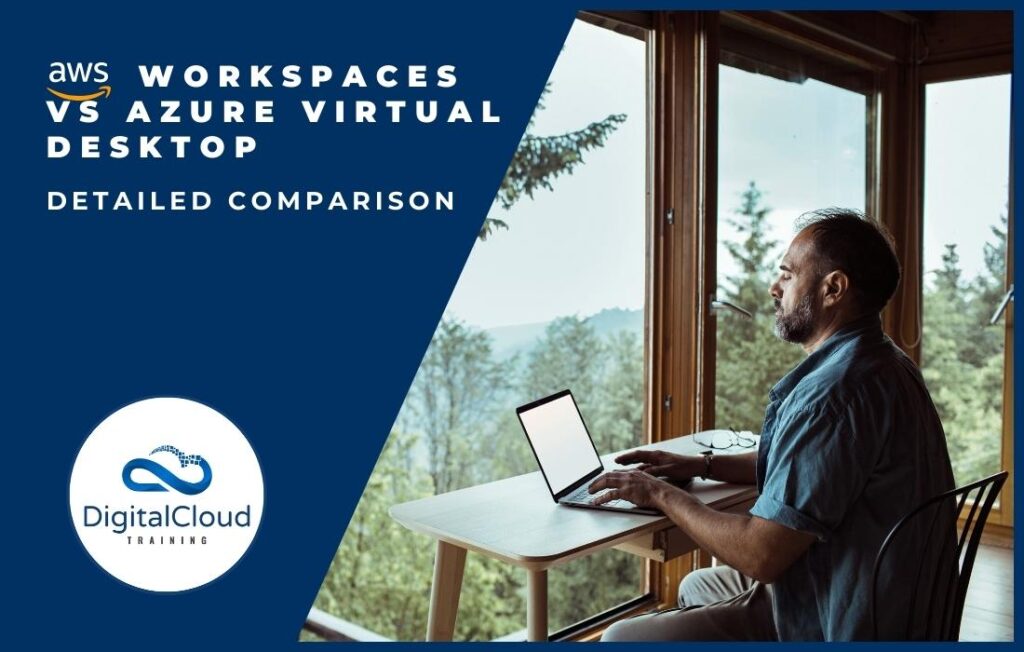AWS WorkSpaces vs Azure Virtual Desktop – Detailed Comparison
Please use the menu below to navigate the article sections:

As the digital landscape evolves, businesses worldwide are leveraging innovative technologies to enhance efficiency while ensuring security and cost-effectiveness. One such revolution in operational adaptability is the advent of Desktop as a Service (DaaS) and Virtual Desktop Infrastructure (VDI) solutions. These cloud-based models, epitomized by prominent services like AWS WorkSpaces and Azure Virtual Desktop, are redefining the concept of the traditional workplace, offering unprecedented flexibility and control in how companies manage their IT resources.
Understanding DaaS and VDI:
DaaS and VDI are groundbreaking because they centralize desktop management, host the operating system on a remote server, and then deliver it over the internet to end-user devices. This technological advancement means that users can access their full desktop experience without being tied to a single physical location or device, facilitating a new level of mobility and disaster recovery potential.
VDI is a technology that maintains desktop images in a centralized server farm, which is typically hosted in a data center. These images are then streamed to end-user devices. The actual computing happens on the server, making it easier to manage and secure your desktop environment.
DaaS takes the VDI concept and turns it into a service. Essentially, DaaS is VDI hosted by a third party, further reducing the investment in, and maintenance of, physical infrastructure that businesses need to support their users. With DaaS, companies subscribe to desktops on a per-user basis, where the DaaS provider is responsible for maintenance, backups, updates, and data storage.
Common use cases for DaaS and VDI:
The versatility of DaaS and VDI is evident through a myriad of use cases applicable to various business scenarios, regardless of size or sector. These include:
- Facilitating Remote Work: By offering a consistent and secure desktop experience, these services support remote or hybrid work arrangements, ensuring that geographical location or device availability does not hinder employee productivity.
- Ensuring Business Continuity: In cases of local disruptions or global crises, DaaS and VDI are integral to maintaining uninterrupted business operations, allowing instant access to essential applications and data from anywhere.
- Safeguarding Sensitive Data: With enhanced security measures, these virtual solutions ensure that critical business data is stored in a centralized location, safeguarded from local device vulnerabilities.
- Streamlining IT Management: Businesses can benefit from simplified IT management, as deploying updates or enforcing policies can be done centrally, eliminating the need for physical access to each device.
- Optimizing Operational Costs: DaaS and VDI help in transitioning from capital to operational expenditure models, with scalable subscription-based pricing that ensures companies only pay for what they need.
- Supporting Temporary Workforces: These services can rapidly deploy or retract secure desktop environments for seasonal or contract employees, providing them with the necessary tools without long-term hardware investment.
By leveraging the strength of AWS WorkSpaces and Azure Virtual Desktop, businesses can address these use cases with high efficiency, ensuring not only the continuity of their operations but also the security and integrity of their data and applications. In the ensuing sections, we’ll delve deeper into each of these services, exploring their unique offerings and how they compare, helping you make an informed decision that best suits your organizational needs.
What is Amazon WorkSpaces?
Amazon WorkSpaces is an innovative virtualization service that eliminates the need to invest heavily in hardware or suffer from capacity planning issues often associated with the physical deployment of desktops. Operating under the Desktop-as-a-Service (DaaS) model, it allows users to operate their desktop computing environment on the reliable and secure Amazon Web Services (AWS) cloud infrastructure.
This product is particularly useful for businesses looking to manage their computing resources at scale efficiently. By leveraging AWS cloud’s powerful capabilities, companies can provision virtual cloud-based desktops that allow their employees to access the documents, applications, and resources they need, anywhere, anytime, from any supported device, including Windows and Mac computers, Chromebooks, iPads, Fire tablets, and Android tablets.
What is Azure Virtual Desktop?
Azure Virtual Desktop, previously known as Windows Virtual Desktop, is a comprehensive desktop and app virtualization service hosted on the global Microsoft Azure platform. This sophisticated service allows you to create a robust and scalable virtual desktop infrastructure (VDI) without the complexity involved in setting up and managing the underlying infrastructure. With Azure Virtual Desktop, users can access a complete modern desktop experience from anywhere, using any device connected to the internet, all powered by the robust security and development ecosystem in Microsoft’s Azure cloud.
This virtualization service is particularly crucial for businesses undergoing digital transformation, enabling them to deliver a secure, productive virtual desktop experience that can quickly adapt to the evolving needs of the company and its workforce.
Azure Virtual Desktop vs AWS WorkSpaces:
1. Features:
Both AWS WorkSpaces and Azure Virtual Desktop offer a broad range of features. AWS provides a scalable cloud desktop experience, and Azure gives a comprehensive desktop and app virtualization. The key difference lies in the details of functionality, such as Azure’s Windows 10 multi-session capability, which isn’t available directly through AWS.
2. Compatibility:
Azure Virtual Desktop is deeply integrated with the Microsoft ecosystem, making it ideal for businesses already embedded in the Microsoft environment. In contrast, AWS WorkSpaces is more system agnostic, providing a variety of options, including Amazon Linux WorkSpaces, proving to be more versatile for diverse OS needs.
3. Integration:
When it comes to integration, Azure Virtual Desktop naturally aligns with Azure’s cloud services, offering a unified experience for those invested in Microsoft’s suite. Conversely, AWS WorkSpaces integrates tightly with AWS services, providing a cohesive environment with other AWS offerings.
4. Deployment:
Deployment in AWS can sometimes be more straightforward, as it allows quick provisioning of desktops without much complexity. Azure Virtual Desktop requires a bit more understanding of the Microsoft ecosystem, especially around Azure Resource Manager, but it also provides broader customization options in return.
5. Performance:
Performance is contingent on various factors, including the type of workload and specific configurations. AWS WorkSpaces allows for consistent scaling, ensuring you pay for what you use without sacrificing performance. Azure Virtual Desktop, with its Azure backbone, promises integrated optimization with Windows 10 and Microsoft 365, potentially offering smoother performance for those applications.
6. Security:
Both platforms offer robust security features, leveraging each cloud’s inherent security offerings. AWS WorkSpaces benefits from AWS’s data centers’ broad security certification coverage, while Azure Virtual Desktop utilizes Microsoft’s security protocols, including Azure Security Center, Azure Sentinel, and more.
7. Pricing:
Pricing structures are complex and contingent on multiple factors for both. AWS WorkSpaces follows a pay-as-you-go model, with pricing based on the number and type of WorkSpaces launched. Azure Virtual Desktop could potentially save costs for businesses already using Microsoft licenses and offers a conditional free tier, but it also incurs costs around additional Azure resources used.
Comparison Table:
Criteria | AWS WorkSpaces | Azure Virtual Desktop |
|---|---|---|
Features | Scalable cloud desktop | Comprehensive desktop and app virtualization; unique Windows 10 multi-session experience |
Compatibility | System agnostic, offering Amazon Linux | Best for businesses embedded in Microsoft’s ecosystem |
Integration | Seamless with AWS services | Unified with Azure services |
Deployment | Straightforward provisioning | Requires familiarity with Microsoft ecosystem; broader customization |
Performance | Consistent scaling; pay for what you use | Optimized for Windows 10 and Microsoft 365 |
Security | Broad security certification | Integrated with Microsoft’s security stack |
Pricing | Pay-as-you-go | Conditional free tier; additional costs for extra Azure resources |
Which is better – AWS WorkSpaces or Azure Virtual Desktop?
Deciding between AWS WorkSpaces and Azure Virtual Desktop isn’t a one-size-fits-all answer. It boils down to your organization’s specific needs, current system configurations, and future scalability plans.
For businesses already operating within the Microsoft ecosystem, Azure Virtual Desktop may be a more seamless transition, offering tight integration with Microsoft services and tools. Its setup provides an environment that might be more familiar to your IT department, potentially minimizing the learning curve.
On the other hand, AWS WorkSpaces offers a compelling, user-friendly option with its straightforward deployment and versatile compatibility with multiple operating systems. If your business desires flexibility outside of just Microsoft products, AWS could be the way to go.
In conclusion, the best approach is to evaluate the needs and structure of your own organization. Consider running a pilot program for each service to gauge performance, ease of use, and compatibility with your existing operations. By identifying the solution that aligns with your strategic objectives, you’ll harness the full power of virtual desktop infrastructure in the cloud.
Ready to Take Your Tech Career to the Next Level?
At Digital Cloud Training, we’re dedicated to your success. Our courses offer up-to-date content, equipping you with the expertise to stand out in the competitive tech job market.
Our On-Demand Training allows you to learn at your own pace, fitting seamlessly into your schedule. Dive into the world of cloud computing whenever and wherever suits you best.
Our Challenge Labs provide practical, real-world scenarios where you can apply your newfound knowledge without the risk of unexpected cloud costs. Gain hands-on experience and sharpen your skills.
For those seeking an immersive experience, our Cloud Mastery Bootcamp delivers live, job-ready training. Led by industry experts, this accelerated program can get you certified faster than you thought possible.
It’s time to propel your tech career forward. Join us at Digital Cloud Training and unlock your full potential in the world of cloud computing.





Responses